How 'The Substance' Uses Practical Effects and Splashy Makeup to Craft a Body Horror Film That Tears Down Beauty Standards
Makeup effects designer Pierre-Olivier Persin and key makeup artist Stéphanie Guillon open up about the behind-the-scenes process on Coralie Fargeat's new movie.


This story contains heavy spoilers for the entirety of The Substance. In Coralie Fargeat’s new feminist horror movie The Substance, harmful societal beauty standards are the real monsters. They (female objectification, the disposal of “the old,” the proliferation of an industry built on body modification) feed a beast of a cycle that leads Demi Moore’s fading TV personality character Elisabeth Sparkle to seek out a black market treatment called The Substance that promises to make her more beautiful. And in doing so, she undergoes a creature-feature-like transformation herself.
The Substance is a grotesque process—one involving syringes, fluids, and Elisabeth’s spine opening up to birth a younger double played by Margaret Qualley. Elisabeth and her counterpart, known as Sue, cannot be conscious simultaneously, so they each live for a week before switching places, with Sue detracting liquid from a gaping hole in Elisbeth’s spine to sustain herself. When Sue abuses The Substance, Elisabeth begins to age—starting with one unnerving, decrepit finger before spreading into creaky, nearly unusable limbs; and when Elisabeth fights back by binge-eating, Sue malfunctions so much so that she can pull chicken wings out of her navel.
In doing so, the film points to the painstakingly ugly lengths some will go to be revered as perfect. It’s executed to a spine-tingling, life-like extent that makes for a body horror film for the ages.
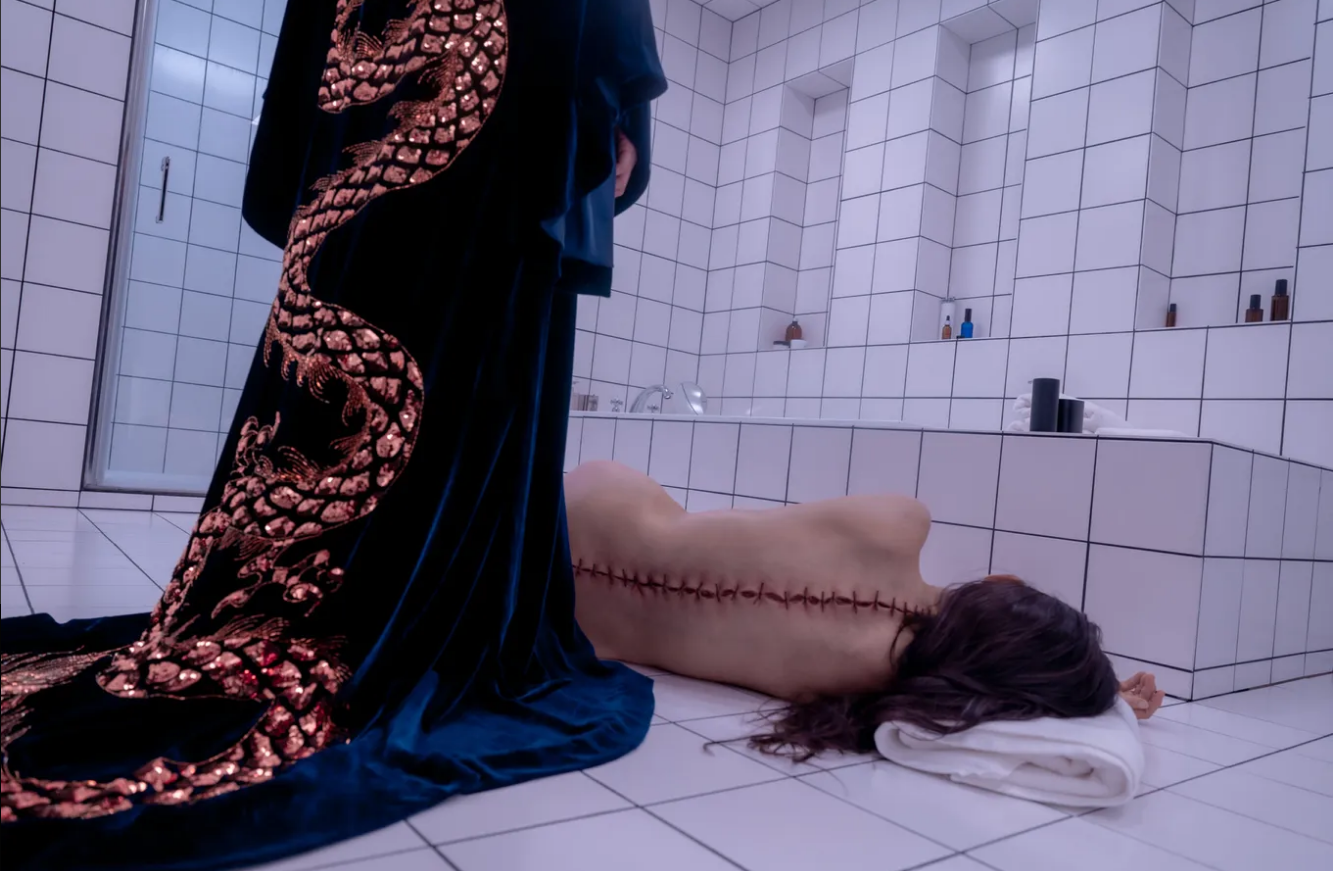
Sue (Margaret Qualley) looks at Elisabeth's body after she takes the "activation" of The Substance.
To bring her vision to life, Fargeat collaborated with prosthetics and makeup effects designer Pierre-Olivier Persin and his team at POP FX. Persin (who previously worked on Game of Thrones) tells Marie Claire that the project was a dream come true. “I remember reading in magazines like Fangoria interviews with the prosthetic artists who did The Fly,” Persin recalls I was 15-years-old in my bedroom and dreaming, looking at the pictures with a magnifying glass, trying to [understand how they did it].”
He adds, “This is not The Fly—it has different sensibilities—but it has that flavor.”
Persin and POP FX worked with Fargeat to design five stages of Elisabeth’s evolution, which they lovingly named “Requiem,” “The Finger,” “Gollum,” “Monstro,” and “Gremlin.” Operating out of their studio in Montreuil, France, as well as a second rental workshop space, they prioritized practical effects—like those out of The Fly and other classic horror movies—with him and Fargeat frequently sending each other clips on YouTube of old-school tricks they hoped to replicate.
Equally as important to the success of the film’s gory aesthetic was key makeup artist Stéphanie Guillon. While The Substance is a nightmarish thriller, it also lives in a splashy, surrealist version of modern-day L.A., and Guillon heralded the pristine beauty looks that enhance Elisabeth and Sue’s star power—especially as the double becomes an image-obsessed monster.
Stay In The Know
Get exclusive access to fashion and beauty trends, hot-off-the-press celebrity news, and more.
With The Substance now in theaters, Marie Claire spoke to Persin and Guillon—two longtime collaborators in French cinema—about crafting Elisabeth and Sue’s looks, building monstrous dummies and a blood rig, and signing up Demi Moore for five-hour sessions in a makeup chair.

Sue (Qualley) looks at a billboard of her new TV show.
Marie Claire: When developing Elisabeth and Sue’s beauty looks, how did you differentiate them?
Stéphanie Guillon: For Elisabeth, I had a bit of a fight with the director because I told her that she had to be beautiful in the beginning [of the film]. It had to be like, ‘Why would they [fire her]?’ Because she has everything, she's beautiful, she still has a show that's going on very well—so I wanted for her to be sparkling and beautiful. Coralie was telling me, ‘No, no, no, she cannot,’ and I said, ‘Coralie, I have to have the time for her to go down deep before she has all the prosthetics and all of that.’
For [Margaret’s character, Sue], I had all sorts of makeup. I was in Korea before [shooting], so I brought back a lot of stuff because they're very good at makeup. I wanted something very cheerful, very sparkling, and pop because that was what Coralie asked for. I made a lookbook with different sorts of makeup inspiration from the ‘80s mixed with [recent] Korean video clips. The sparkling stuff that I picked [was from] watching BLACKPINK videos. And then I also went to look at makeup artists who do a lot of fashion shows because they can do stuff that we don't do in the movies.
MC: When Sue starts abusing The Substance, Elisabeth starts aging. Was there a clear vision Coralie had of how that was supposed to look, or was the effects team able to come up with a plan and say, ‘Let’s start with her finger?’
Pierre-Olivier Persin: The design phase was very long. Coralie had a clear vision, but she didn't know what she wanted to see. Especially for Demi's transformation into a hag, she wanted to go too far too quickly. I thought we needed a progression to have a few stages before suddenly everything goes wild. There was a couple of fights about that too. [My perspective was] it'll be wild and insane eventually, so let's keep the holes from running at the beginning and hold the throttle.

MC: Was the unzipped spine on Elisabeth’s body and the hole in her back that Sue detracts liquid prosthetics on Demi Moore’s body, or was there a dummy built?
POP: It was a little bit of everything. We had quite sophisticated silicon dummies. We had two for the birth. We also had matching prosthetic makeup on the body double and some days we applied the makeup on Demi.
MC: For much of the movie, Demi is half-elderly-half-normal. How long did it take for her to get into makeup?
POP: When it was half the face, one arm, one foot, one leg, and the full-back prosthetic, it took five to six hours.
That makeup was more difficult than when she's completely gone because the full body is covered. But when it's just half of the face, I didn't want it to look like makeup from makeup school—when you are training students and you do half of the face aged and the other half is normal. I was really frightened of that. Also, when you add prosthetics to a face or body, you add volume. If you’ve built up half the body, but the other half is not built up, suddenly, the old arm that is supposed to be skinny looks bigger than the normal arm. So, it was a matter of trying to come up with the thinnest prosthetic as possible, while at the same time trying to be as gruesome as possible.

Elisabeth (Moore) smears her makeup out of frustration.
MC: While the body horror is shocking, the most stirring scene might be when Elisabeth smears her makeup out of frustration and starts to harm herself. What was it like doing her makeup for that scene?
SG: We did that, I think, 10 times. My primary concern was Demi’s face. So I prepared a lot of stuff that was easy for her. All of the pads were already wet with product for her to not have too much to start with. But Demi is Demi, so she went for it. So it was like, ‘Oh, my God, she's going to have eyelashes all around and all of that.’
My concern was she's going to hurt herself. At the end, I did something that I never did on a movie, ever. I told Coralie, ‘That's enough. You cannot do it anymore because she's going to have a rash all around the face.’ Coralie said, ‘Yeah, yeah, yeah, okay, okay, no problem.’ But of course after the 11th [take], she said, ‘We are going to do it once again,’ and I took the remover pad and I squashed everything, and I said, ‘I removed everything, that's over. You have already 11. You cannot have more because tomorrow she will have a red face.’ Normally you don't do that! But it was too much because it was very hard on her skin.
MC: It’s her lipstick that she smears, and lips become somewhat of an obsession of Elisabeth’s as she studies Sue’s and tries to copy them. Do you remember what brand of lipstick you used?
SG: It was Charlotte Tilbury. We used a lot of Charlotte Tilbury.
For Margaret, we used Danessa Myricks, especially for the eyes when she dances—because that stuff doesn't move. The nail polish was an American brand that I love, Zoya.
MC: Elisabeth’s transformation is jarring but it doesn’t necessarily become hagsploitation where the audience is disgusted by and scared of her when she looks elderly. Did you have any conversations with Coralie about that differentiation?
POP: Coralie was really concerned about Monstro, the creature in the end. She asked [another] company to do designs, and she was unhappy with them. So they called me, and I saw the designs and they were very good—but they were very masculine. I think Coralie really wanted something more feminine. I tried to put that sensibility in those designs rather than doing a rubber monster for the guys. I tried to add some humility in it, and then gracefulness, even if it's all crazy.
I don’t know if [Coralie] wanted to offend people, but she does not care if you go too far. As a prosthetic artist, many times we go very far with what we are doing, but she was pushing us more—more colors, more blood, more bumps, more. And she was quite hard with her characters. There's the commentary on society, but also there is a commentary on the behavior of those characters. It goes both ways.
I tried to put that sensibility in those designs rather than doing a rubber monster for the guys. I tried to add some humility in it, and then gracefulness, even if it's all crazy.
Pierre-Olivier Persin
MC: What was the process like designing the monster that Sue creates after using the remaining “activation” of The Substance in the final sequence?
POP: That was the hardest, and it took months. We designed completely from scratch. We did tons of maquettes in every way possible. We did old-school, plastic maquettes, hand-sculpted, state-of-the-art computer-generated maquettes, Photoshop—everything in between. In the end, it's an old-fashioned plastic maquette. I looked a little bit [to] Niki de Saint Phalle. She was a French sculptor from the ‘60s who had done female dancers with a fat body on tip-toes. [Coralie] wanted the feeling like the elephant with a dancer and with tons of breasts. So that was tricky.
[Filming it], we had a stunt double for the wide shots. At first, Coralie was like, ‘I want to put Margaret inside the suit,’ and I was like, ‘But it's going to be only one eye. She's going to be completely twisted.’ Coralie insisted that she wanted to have Margaret for the close-ups. I have to say, watching the movie, she was right because that's really a performance and you can see that's her.
MC: How did you create the explosion of blood that comes from Monstro in that scene?
POP: It was really a teamwork. There was a stunt crew, special effects—Jean Miel, the special effects supervisor, took care of all the blood rig because it was like a fire hose. It’s like what the firemen are using to put fire down; it was the same stuff with blood.
The set was built a certain way because we needed to hide massive tubes under the floor. What was really great with the movie was it was really willing to use as much practical effects as possible.
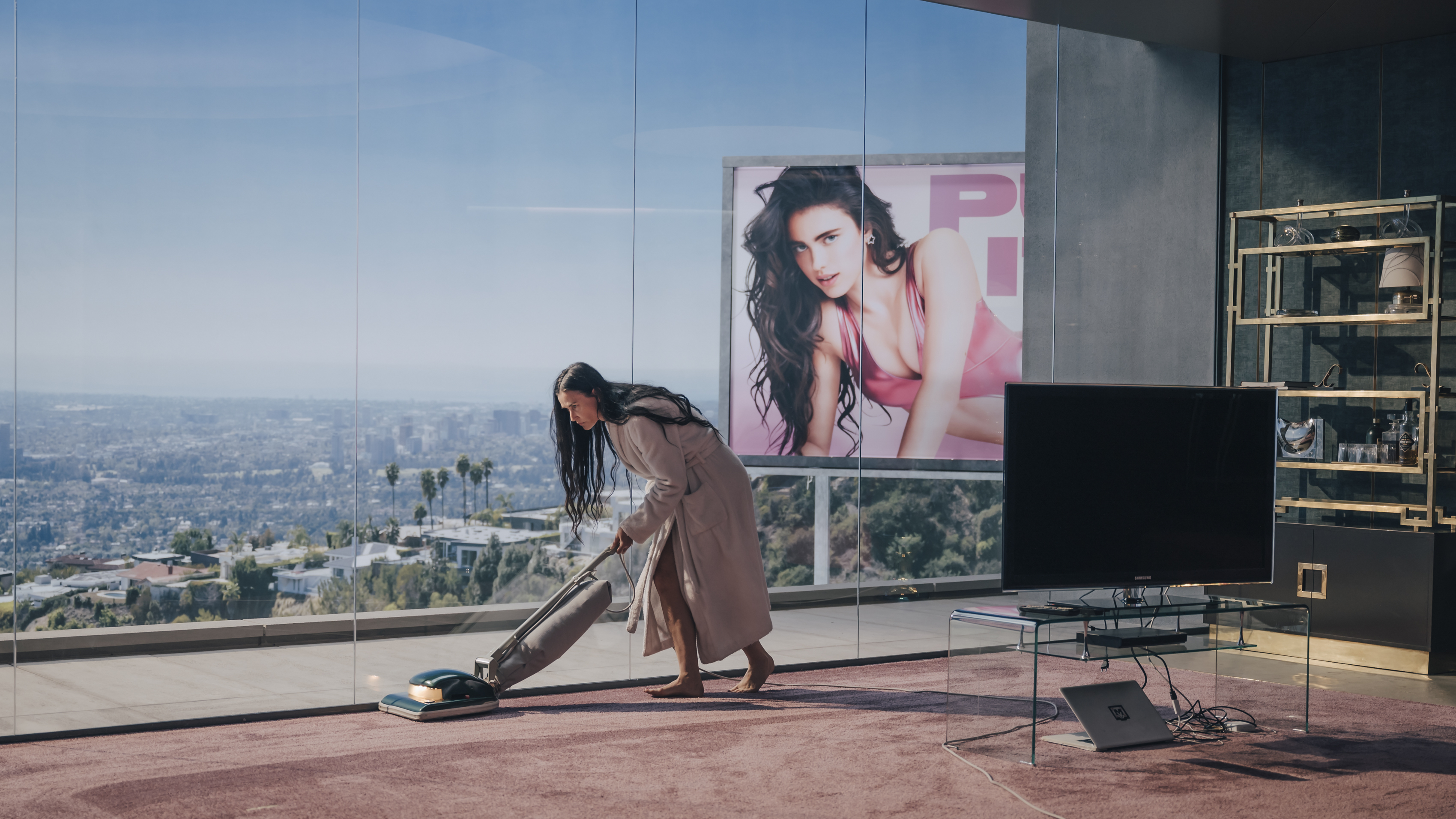
Elisabeth (Moore) cleans her apartment, overlooking a Billboard of Sue (Qualley).
MC: You both spent a lot of time with Margaret and Demi in applying their makeup and prosthetics. Did you have any favorite memories working with them?
SG: [Demi] is someone with a very big heart. Working with her was a great pleasure for me—someone who will stay in my heart for a long time. Margaret is the same.
Demi also lets you work properly. For us French, it’s something! It's really different to work with English or American actors because the French ones are very spoiled! [laughs] For example, we were shooting the scene with Demi when she has half the face old age and goes to the shower. It was like five hours of makeup, we do the scene, and it’s not working properly, so we do another scene, and at the end of the day, Coralie says, ‘Okay, we’re going to go back to the first scene,’ So [Demi] has [to reapply] all the prosthetics from the morning. Demi told Coralie, ‘No, we are not going to do that because the prosthetic is now on me for so long, and it's not looking as good as this morning. So, to respect the work of the people who did it this morning, I think it's better to shoot it tomorrow.’ We were like, ‘Wow, we love you.’ That is something I've never seen on set in France.
She also did one thing [when] there was an issue with a body double who had to stand there for lighting stuff, and she had to be naked for the movie. [Demi] told her, ‘If you are uncomfortable with this, don't do it. If you are uncomfortable, you just tell me, and I’ll tell them that you have to do it with something on you.’
POP: When you [get prosthetics applied in my chair], it's like going to the dentist for six hours. So I'm not so sure that the pleasure was mutual, [laughs] but Demi is very witty and fun, and she's a trooper. Even for grueling five, six hours of makeup, she’s standing or in the chair. Many actors are mobile or bending their heads, looking down, and you are trying to glue very complicated prosthetics. She never did that—never, never ever. She’s with you all the way through, which is quite rare. She had her little chihuahua dog. Whatever she was wearing or if she had a blanket on, you could see something trembling and bulging eyes [peeking out].
This interview has been edited and condensed for clarity.

Sadie Bell is the Senior Culture Editor at Marie Claire, where she edits, writes, and helps to ideate stories across movies, TV, books, and music, from interviews with talent to pop culture features and trend stories. She has a passion for uplifting rising stars, and a special interest in cult-classic movies, emerging arts scenes, and music. She has over eight years of experience covering pop culture and her byline has appeared in Billboard, Interview Magazine, NYLON, PEOPLE, Rolling Stone, Thrillist and other outlets.
-
 How Kate Middleton Is Influencing George's Fashion Choices
How Kate Middleton Is Influencing George's Fashion ChoicesThe future king's smart blazer is straight out of Princess Kate's style playbook.
By Amy Mackelden Published
-
 King Charles "Couldn't" Meet Prince Harry During U.K. Visit
King Charles "Couldn't" Meet Prince Harry During U.K. Visit"It could actually bring down a court case."
By Amy Mackelden Published
-
 Hailey Bieber and Kendall Jenner Usher in Spring
Hailey Bieber and Kendall Jenner Usher in SpringBieber wore $450 heeled sandals, while Jenner opted for The Row's rubber flip flops.
By Amy Mackelden Published
-
 Every Ruth Ware Book, Ranked—From 'In a Dark, Dark Wood' to 'The Woman in Cabin 10'
Every Ruth Ware Book, Ranked—From 'In a Dark, Dark Wood' to 'The Woman in Cabin 10'Here's what you should read before her new thriller 'The Woman in Suite 11' hits shelves.
By Nicole Briese Published
-
 10 Books to Read for a Killer Vacation
10 Books to Read for a Killer VacationPack these novels about vacations gone very wrong on your next trip.
By Liz Doupnik Published
-
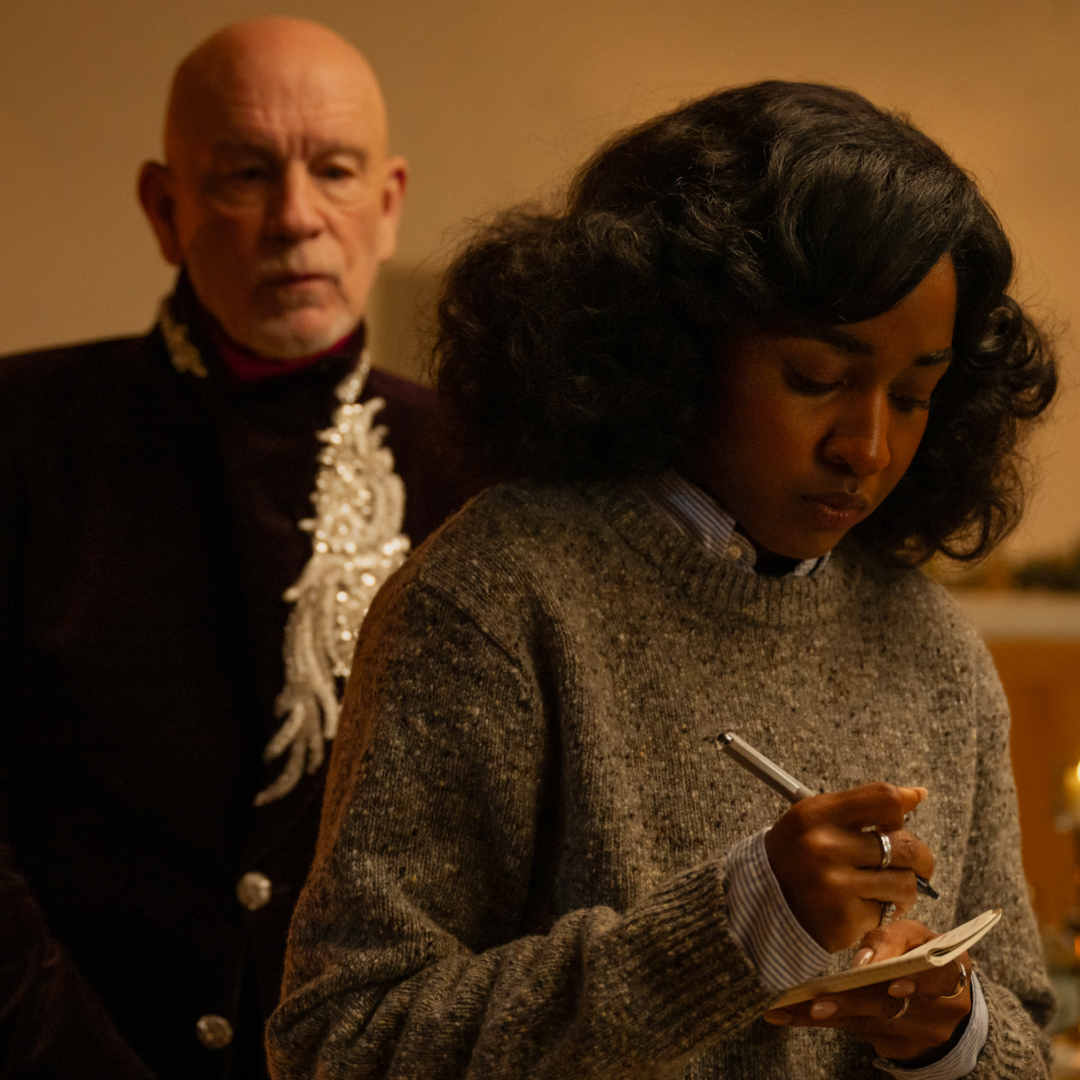 In 'Opus,' Cult Leaders and Pop Stars Are One in the Same
In 'Opus,' Cult Leaders and Pop Stars Are One in the SameThe A24 film's costume and production designers open up about crafting fictional pop icon Moretti’s style and mysterious estate.
By Sadie Bell Published
-
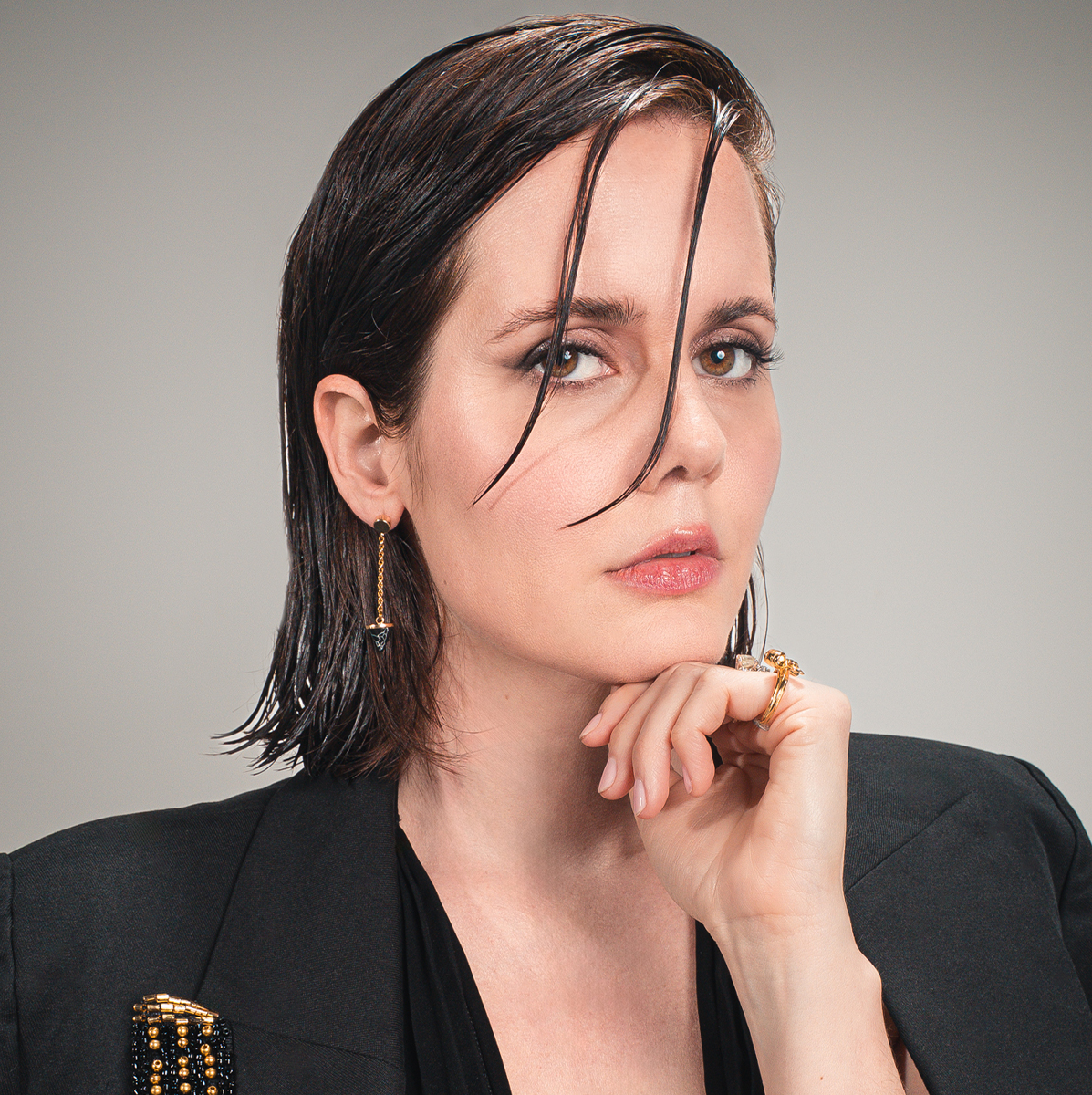 Ashley Sutton Is Not Going to Take Things Lying Down
Ashley Sutton Is Not Going to Take Things Lying DownThe actress who plays Hannah has been dying to talk about the Showtime hit's major twist for months.
By Sadie Bell Published
-
 'On Becoming a Guinea Fowl' Is a Revolutionary Call to Speak Up Against Female Abuse
'On Becoming a Guinea Fowl' Is a Revolutionary Call to Speak Up Against Female AbuseAfter showing how a culture of silence around abuse can devastate entire generations, the arresting A24 film holds a mirror up to the audience and asks, \201cWhat happens if we scream?\201d
By Quinci LeGardye Published
-
 'Paradise' Finale Recap: Breaking Down the Shocking Season 1 Ending
'Paradise' Finale Recap: Breaking Down the Shocking Season 1 EndingWe're still reeling from all of those twists!
By Radhika Menon Published
-
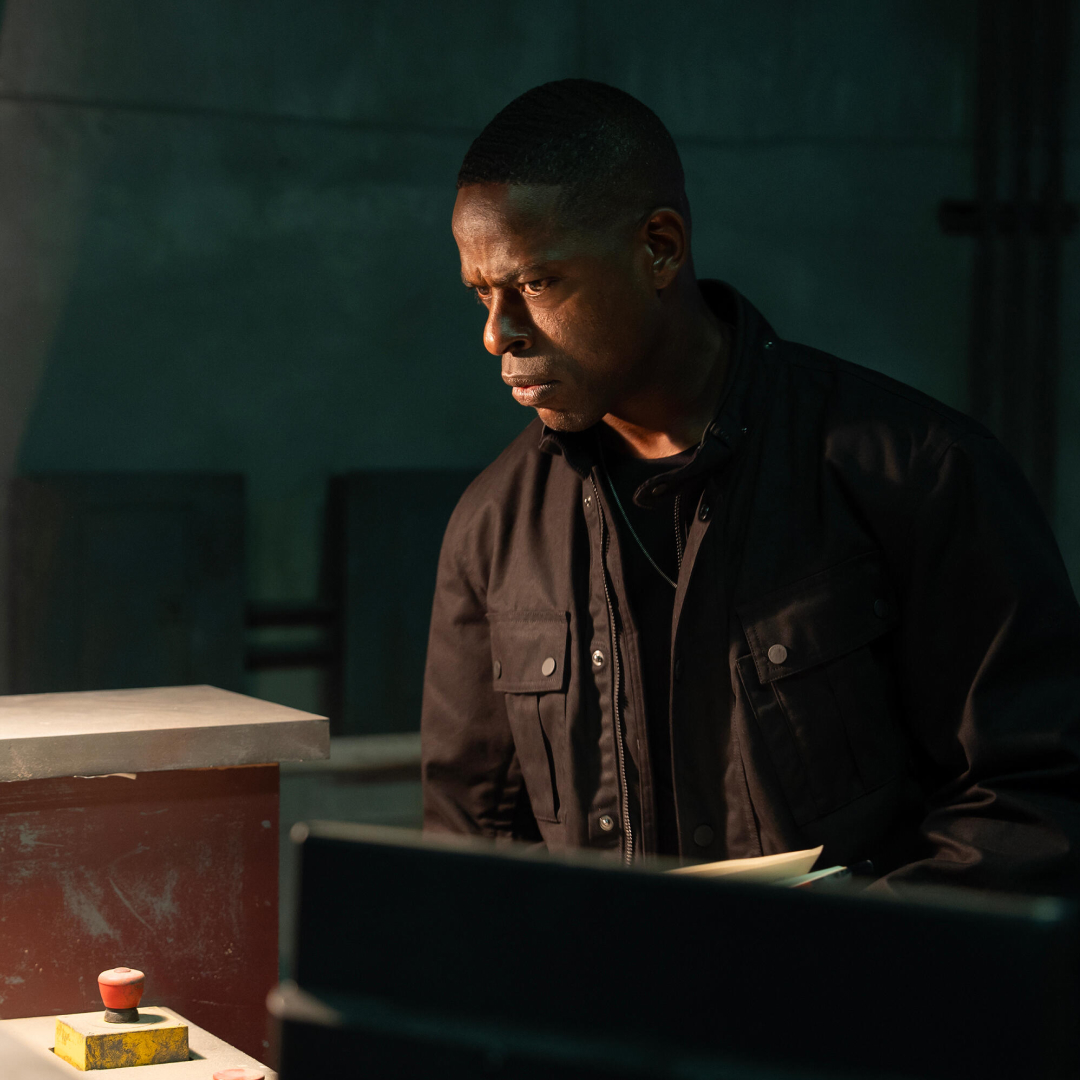 'Paradise' Season 2: Everything We Know
'Paradise' Season 2: Everything We KnowHere's everything we know about the next installment of the twist-filled series.
By Quinci LeGardye Last updated
-
 'Anora' Star Mikey Madison Takes Home the Best Actress Award at the 2025 Oscars in a Surprise Win
'Anora' Star Mikey Madison Takes Home the Best Actress Award at the 2025 Oscars in a Surprise Win"I will continue to support and be an ally."
By Quinci LeGardye Published